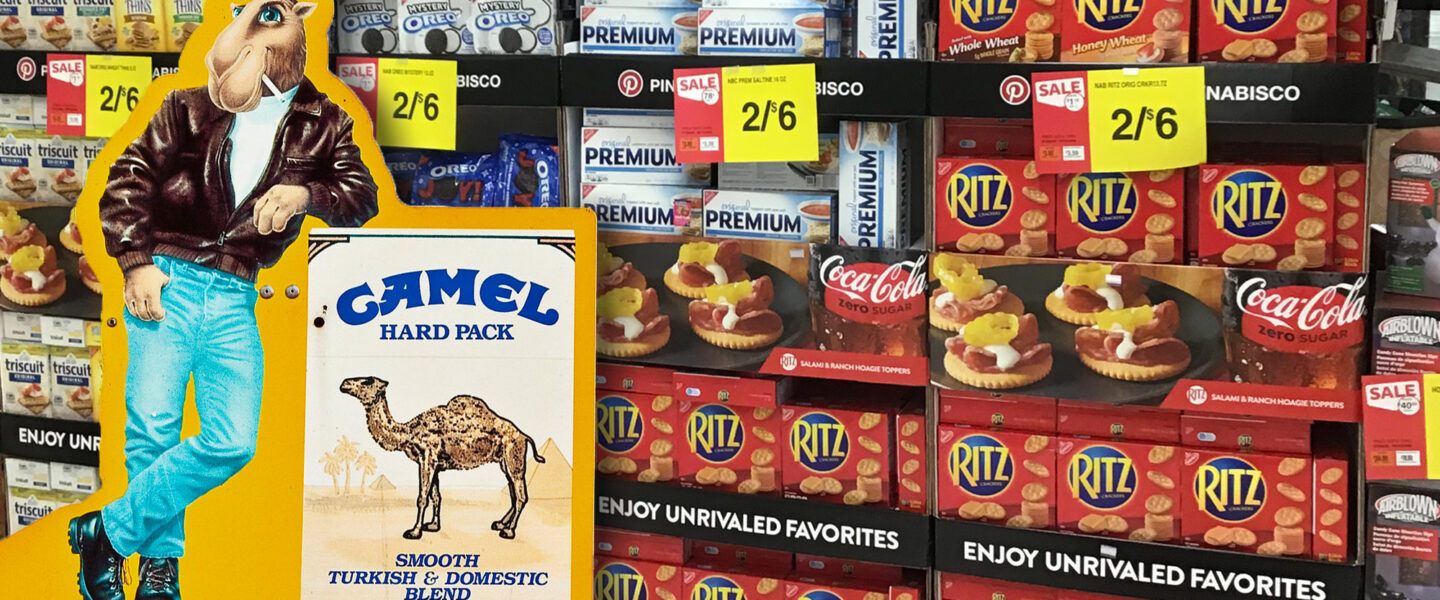Saturday Hashtag: #TheBigTobaccoAddictionStrategy
The Covert Takeover of the US Food Industry
Welcome to Saturday Hashtag, a weekly place for broader context.
|
Listen To This Story
|
The consumer driven anti-smoking campaigns of the1990s effectively shut down US smoking rates, but a more insidious and pervasive threat quietly infiltrated American homes. This time, the danger wasn’t concealed in the well-known hazard of cigarettes — it was embedded in ultra-processed foods, meticulously engineered for addiction.
The twist? Trusted American food brands began fronting for the same tobacco companies that spent millions manipulating legislation and lying about health risks.
While Big Tobacco’s grip on nicotine waned, they slipped their Purdue Pharma addiction strategy to the US food industry, transforming all the brands and products we trusted into more harmful and profitable versions of their past selves.
The Tobacco-Driven Food Takeover
On the surface, tobacco companies appeared to be beginly diversifying into the food industry. But this was no random shift — it was a calculated move to apply their addiction expertise to food products.
By the late 20th century, the food industry had become the new frontier for Big Tobacco, using the same deceptive marketing tactics honed for cigarettes to subvert our perceptions.
The Acquisition of Food Giants
Big Tobacco began acquiring major food brands. Philip Morris purchased Kraft in 1988 and RJ Reynolds acquired Nabisco in1985, capitalizing on the booming processed food market, all while still profiting from tobacco.
By the end of the 1990s, tobacco companies had significant control over the US food market. Their strategy was simple: diversify into a “safe” industry (unsullied by their previous duplicity) then apply their scientific and financial power to make food just as addictive as cigarettes.
The effect on the industry was significant because now the brands not bought up, like Coca-Cola, Pepsi, and Quaker Oats etc, all had to address the challenge of big tobacco’s addiction strategy.
The Science of Addiction Applied to Food
Once established in food, Big Tobacco deployed its addiction experts to apply the same nicotine-driven tactics to food, making products more addictive, palatable, and profitable.
Top scientists weren’t just concerned with food’s taste — they were obsessed with creating sensory experiences that would trigger cravings and encourage overeating. Using their knowledge of addiction chemistry, they engineered combinations of sugar, fat, and salt to make food “hyper-palatable” — irresistible and hard to put down.
Studies show that ultra-processed foods from Big Tobacco-owned brands are far more likely to trigger overeating and addiction-like behaviors. This isn’t accidental; it’s the result of carefully calculated science designed to hijack our biology and keep us hooked.
The Food Pyramid: A Smokescreen for Processed Foods
Big Tobacco’s monied infiltration of the food industry, combined with their history of manipulating research, made influencing the US Dietary Guidelines a walk in the park.
The infamous food pyramid, which dominated American nutrition standards from the 1990s through the 2010s, was already shaped by heavy industry lobbying. A staggering 95 percent of the advisers behind the pyramid and other nutritional guidelines had financial ties to the food and beverage industry, including those owned by tobacco giants. The foregoing, combined with the massive lobbying power of these companies, resulted in a distorted view of what a healthy diet should look like — one that prioritized sugars, carbs, grains, and processed foods over fruits, vegetables, and whole foods.
The food pyramid wasn’t just a guideline — it was a strategic document designed to position ultra-processed foods (designed for addiction) as staples of a healthy diet. By prioritizing bread, pasta, and cereal while downplaying fat and protein, it served the interests of processed food manufacturers who could mass-produce these carb-heavy chemically enhanced products.
The Aftermath: A Profoundly Sick Nation Hooked on Junk Food Is no Coincidence
The quiet manipulation of both the food industry and public health guidelines directly contributed to the sharp rise in obesity rates through the 1990s and 2000s. Today, nearly 80 percent of Americans are overweight or obese (223M) and/or suffering from chronic conditions like diabetes/prediabetes (97.6M), heart disease (162.4M), high blood pressure (119.9M), and diminished brain and neurologic function (50M) — all directly linked to poor diet and the overconsumption of ultra-processed foods.
While there is indication that Big Tobacco has diversified out of portions of the food industry, the technology and the strategies are still in place and the consequences are clear: Most of the population now struggles with food addiction and significant health issues, yet the culprits remain hidden behind glossy packaging and slick marketing of health friendly front companies.
The food industry with its lobby efforts has evolved from simply providing sustenance to hijacking our biology — and much of this transformation can be traced back to the influence of companies owned by Big Tobacco.
The Future of Food
As we begin to wake up to the role ultra-processed foods play in fueling our health crisis, the calls for reform are growing louder. Advocates are pushing for clearer labels and stricter regulations on food advertising — especially to protect kids.
But this isn’t just about corporate greed. It’s a wake-up call about how the industrialized food system shapes not only what we eat, but how it’s sold to us. To break free from this addiction cycle, we need to look beyond what’s on our plates and challenge the systems that created this mess.
Sure, you can’t overeat broccoli or grass-fed steak — but processed junk? That’s a whole different story, hijacking our biology one bite at a time.
Without Immediate Action Nearly 260 Million People in the US Predicted To Be Overweight or Obese by 2050
The author writes, “Over the past three decades, there has been a startling increase in the prevalence of obesity across the USA, at least doubling in adult men and women (aged 25 and older) and older female and male adolescents (aged 15-24 years) since 1990, with the number of people living with overweight and obesity reaching over 208 million in 2021 — a trend set to continue in the coming decades without significant reform.”
How The FDA’s New Nutrition Labels Could Prod the Food Industry To Get Healthier
The author writes, “A new government proposal to display nutritional labels on the front of food packaging is aimed at helping Americans make more informed choices about what they eat. An eventual side effect, research and expert commentary suggests, could be nudging the food industry to make healthier food, too.”
Project 2025 Outlines Devastating Changes To USDA and the Federal Nutrition Programs
From the Food Research & Action Center: “Organized by the Heritage Foundation, Project 2025 is a ‘presidential transition project’ that makes numerous policy recommendations that would negatively impact the federal nutrition programs as well as other critical federal anti-poverty, education, and health programs. The policy proposals would also weaken federal offices, departments, and regulatory agencies. The over 900-page Mandate for Leadership 2025: The Conservative Promise includes 30 chapters, with Chapter 10 detailing their proposals for the U.S. Department of Agriculture (USDA) and the federal nutrition programs.”
Why Is the American Diet So Deadly?
From The New Yorker: “A scientist tried to discredit the theory that ultra-processed foods are killing us. Instead, he overturned his own understanding of obesity.”
Did Tobacco Companies Also Get Us Hooked on Junk Food?
The author writes, “The chemically addictive fatty, salty and sweet foods that make up 68% of the American food supply have historically been pushed to consumers by the nation’s leading tobacco sales companies … suggesting the same companies are responsible for what has been called a ‘smoking epidemic’ could also be partially blamed for a decline in Americans’ health.”
RFK Jr. Will Have an Early Opportunity to Influence What Americans Eat
From Politico: “If confirmed to lead the Department of Health and Human Services, Kennedy would be responsible for naming some of the people tasked with rewriting the Dietary Guidelines for Americans, one of the federal government’s most powerful tools to shape public perceptions about what’s healthy — and what’s not. It may ultimately be one of his best shots at reining in the ultra-processed foods and food additives that he blames for making Americans sick.”
Introducing the New Food Pyramid
The author writes, “The Food and Drug Administration, which will soon consist of about three people and one AI bot to cut cost, has been hard at work developing new guidelines for what makes a healthy American diet. In preparation for the new administration, we present to you the 2025–2028 guide to daily food choices.”




